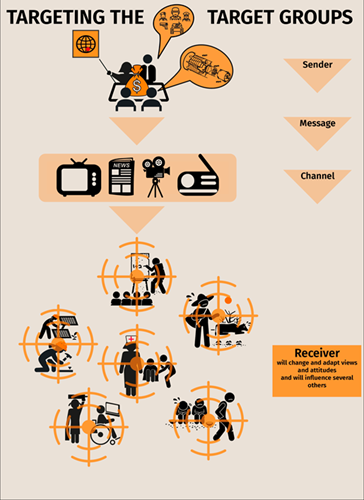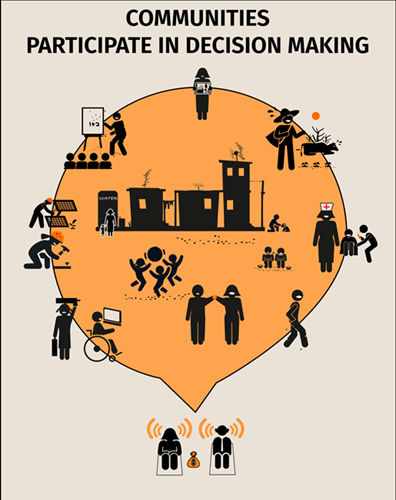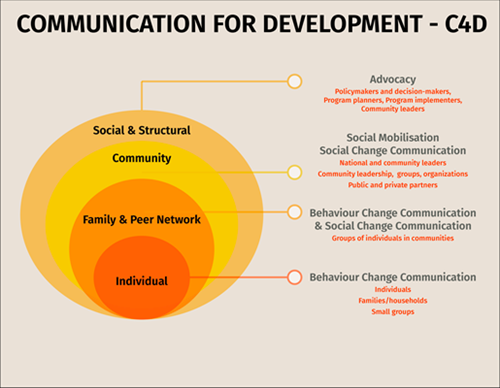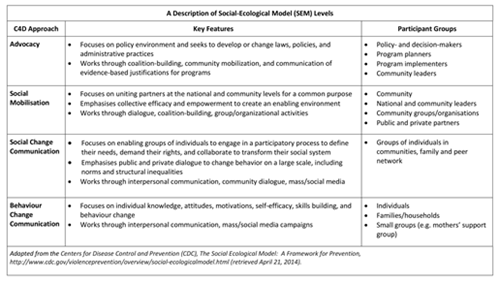Insight
Why ‘Targeting the Target Group’ is out!

Insight
Communication for Development or C4D - a brief look at a long history - and its relevance in times of COVID-19
‘Targeting the Target Group’ is a metaphor from the military to describe processes in communication that originate from the basic Sender-Message-Channel-Receiver model. This was the predominant model of communication from the 1940s until the 1960s to describe how communication works, and not only in development. The theory behind it was to target people in poorer countries and liberate them from poverty with knowledge transfer and technology from developed countries. Disseminating information in mass media was seen as the ideal way to enlighten the poor and foster economic development.
Emerging psychological research has told us that something as simple as a single metaphor (eg. target) can have consequences for how we think and have profound influences on how we conceptualise and act with respect to important societal issues. Moreover development and communication theories have taken a dramatic shift from a one way, top-down transfer of technology, knowledge and information to participatory approaches and have by now reached most of international development agencies and changed their approach towards development, adding the adjective sustainable to the noun.
The paradigm after the Second World war was 'modernisation' with the main objective to fight poverty by "making the benefits of our scientific advances and industrial progress available for the improvement and growth of underdeveloped areas". (1)
The role of the richer countries was to address the 'underdeveloped' poorer countries. In 1949, US President Harry S. Truman made it clear that achieving greater production would lead to peace and prosperity for the whole world. (2)
The prevailing wisdom at the time was that people from developed countries possessed the knowledge which should replace traditional practices or at the very least complement them so that 'progress' could be achieved. The mass media were seen as having the potential to act as key agents of change by "blowing the winds of modernisation into isolated traditional communities and replacing the structures of life, values and behaviours with one seen in modern western societies." (3)

After WWII, mass media were viewed as ideal tools for transferring new ideas and practices from the developed to the developing world and from urban to rural areas. A widespread belief among policy-makers was that information can be transmitted in a linear, essentially top-down, fashion from one point to several others and receivers will change and adapt views and attitudes. Failed projects in the 1960s and the influence of Latin American theorists in the 1970s led to a revision of the modernisation paradigm.
In the 1970s, the modernisation paradigm came increasingly under fire by Latin American theorists, educators and philosophers such as Paolo Freire and others (4) because it neglected the relevance of local social, political and cultural context. It expected development to occur along a consistent well-defined linear sequence, and it put the blame on developing countries for their conditions – ignoring the historical circumstances that led to their subordinate positions and kept them dependent on other richer ones.
"If you want development to be rooted in the human beings who have to become the agent of it as well as the beneficiaries, who will alone decide on the kind of development they can sustain after the foreign aid has gone away, then you have got to communicate with them, you have got to enable them to communicate with each other and back to the planners in the capital city. You have got to communicate the techniques that they need in order that they will decide on their own development. If you do not do that, you will continue to have weak or failing development programs. It's as simple as that. No innovation, however brilliantly designed and set down in a project plan of operations, becomes development until it has been communicated."
Erskine Childers, From Sharing knowledge, FAO’s video programme (8) on communication for sustainable development.
In Latin America, this dissent sparked the genesis of the Dependency Theory, which conceptualised the world as an industrialised core, represented by relatively few rich countries, and an underdeveloped periphery comprising many poor countries. (5) Under this theory, the colonialist and capitalist ‘core’ was perceived as developing at the cost of former colonies, whose main role was to supply raw materials and cheap labour to richer countries, making it impossible for the latter to ‘catch up’.
By the late 1970s, it was abundantly clear that members of the public were not passive recipients of information and that media alone could not change people’s mindsets and behaviours. (6)
Since then, communication has changed from information dissemination to participatory concepts and making peoples’ voices heard in society. These new models have cumulated in a concept called Communication for Development or C4D for short.
The shift from media to people, from products to process
As a result of the dissent and different approaches towards development theories, different models of development communication emerged within specific cultural, geographical and ideological contexts.
Erskine Childers, a pioneer of C4D, worked as early as in the 1960s in the United Nations Development Programme (UNDP) towards forming a distinctively new approach towards communication as part of development interventions (7).

Over time, in response to changing needs and a growing understanding of how development initiatives affected different groups in society, communication approaches have substantially shifted from being technology-centred to people-centred. Communication for development (C4D) refers to a broad term employed by UN agencies to describe a social process aimed at promoting dialogue within communities and between communities and policy-makers to facilitate the achievement of human development goals.
In 1997, the UN adopted the following formal definition of C4D: "Communication for Development stresses the need to support two-way communication systems that enable dialogue and allow communities to speak out, express their aspirations and concerns, and participate in the decisions that relate to their development." (9)
C4D is a social process that promotes dialogue between communities and decision-makers at local, national and regional levels. Its goal is to promote, develop and implement policies and programmes that enhance the quality of life for all. (10)
This definition already includes some crucial features of development communication. First, it is a process; second, it is an analytical activity based on dialogue and, third, it aims to achieve change. This implies that to be most effective it should be used from the beginning of the development intervention, i.e., identification and assessment of priorities and not just in the planning and implementation stages.
In 2006, the World Congress on C4D held by FAO and World Bank in Rome (11) defined C4D as: "…a social process based on dialogue using a broad range of tools and methods. It is also about seeking change at different levels, including listening, building trust, sharing knowledge and skills, building policies, debating and learning for sustained and meaningful change. It is not public relations or corporate communications." (12)
The UNDP believes that information and communication focused interventions are central in bringing about such participation. It believes that genuine involvement and participation can only occur if the information needs of all citizens (including those at the margins of societies) are met and the voices of those most affected by development decisions are heard.
It has become clear "that the media-centric conception of communication was not making a significant difference in people’s lives. Too often the most important missing element in development programmes was genuine (two-way) communication between the decision-makers, the experts, and the so-called beneficiaries," wrote Paolo Mefalopulos in a book on C4D published by The World Bank. (13)
"Media, no matter how technologically advanced; messages, no matter how skillfully packaged; and information, no matter how relevant, are not enough to bring about meaningful and sustainable results. These results can only be achieved if the people involved (stakeholders) are part of the process leading to change...
"It is more than transmitting information; it is about using communication to generate new knowledge and consensus in order to facilitate change...
"Development Communication can be defined as a ‘dialogue-based process entailing the strategic application of communication approaches, methods and/or technologies for social change’." (14)
If there is no communication assessment in the beginning, the process would be flawed and could hardly be regarded as C4D. (15)

The Social-Ecological Model as developed and used by UNICEF shows the communication strategies that make up the C4D approach.
C4D happens on different levels and uses a combination of interventions at all levels of the model. It is important to note that the different approaches can apply to levels other than the one they are next to, for example, the advocacy approach can also be used at the community or organisational levels.

People all over not only face difficulties to understand and apply expected behaviour in response to the Corona pandemic, additionally there is a lack of opportunity on one hand, fear, panic and alarm on the other.
By now, a consensus has emerged about the behaviours that the general population should be enacting to reduce their risk of contracting or spreading COVID-19.
But the difficulty is that there is a general knowledge-action gap. That means just giving out messages is not enough to change behaviour. The knowledge-action gap might simply be the result of the living conditions and lack of opportunity. If you don’t have water and soap, what do you do?
So three factors are important to adapt new behaviours: people must have the capability, opportunity and motivation to do so.
Informal settlements face considerable challenges around the control of COVID-19, but locally developed strategies could mitigate the worst of the outbreak as long as action is taken quickly. Preparedness and early action by local governments and communities is essential. Once an outbreak occurs escalation can be rapid, leaving little room for further planning.
There can be a high level of local organisation within informal settlements (e.g., community health worker networks); "It is crucial that responses to COVID-19 are organised through these groups and leaders who know their settings best and have existing links to residents.” (16)

An example of innovative design for informal communities from South Africa.
The TV has relentlessly broadcast messages to people telling them how to behave. The media has also broadcast heartrending visuals of coffins in Italy and the stories of people dying alone. These messages and sometimes drastic reports have also not helped to change behaviour in a positive way, but led to tragic events: "A few days ago, a man suspected to be infected jumped off from the 7th floor of the hospital in Delhi to his death," reported a colleague from India. "We also had the quote of a chief minister of an Indian state who remarked that there would be 'shoot at sight' at anyone who violated the lockdown over corona."
The unprecedented global lockdowns have made this the most urgent challenge in recent human memory, a challenge that has brought together the world health and scientific community in a bid to win the fight against COVID-19. (17)
The world has faced epidemics before and there is a wealth of experience and many lessons from the global work around HIV / AIDS and polio that can be utilised to help stop the pandemic. Whether it be engaging communities, working with religious and other influential groups, building trust with marginalised and vulnerable groups, tracking and responding to rumours and misinformation, building relationships with media and journalists, or gathering data to guide local decision-making, HIV/AIDS and polio communication programmes have much insight to offer.
It was found in HIV/AIDS communication that marginalised communities showed greater behaviour change through positive messaging and inter-personal communication, than through one-dimensional fear messaging. The most difficult issue in times of HIV/AIDS was that of 'stigma' and the fact that people were not voluntarily getting tested enough, or not opening up and sharing their HIV+ status with their family, or worse taking extreme steps when finding out that they were HIV+. Rudely awoken by the many suicides of people who were living with HIV, the communication messaging went through a drastic change. There was hope and positivity that specifically addressed the stigma around people who might be living with HIV. From then on, strategic communications turned back whatever damage that the skull and crossbones imagery might have done to focus on positive, hopeful messaging.
Today, there's far too much panic and rumours stemming from non-science 'news'. Calling it the Chinese virus or the killer / deadly virus etc. causes further divide and disturbance.
The design company IDEO decided to explore parallels that could be drawn between health behaviour changes like quitting smoking to behaviours like handwashing and physical distancing.
Three main insights are outlined in their report, which drew on three behaviour change theories: the Health Belief Model, the Transtheoretical Model, and Diffusion of Innovations with examples, illustrations, and quotations.
Engages communities and decision-makers at local, national, and regional levels, in dialogue towards promoting, developing, and implementing policies and programmes that enhance the quality of life for all
1 Harry S. Truman in his speech https://avalon.law.yale.edu/20th_century/truman.asp
2 Ibid
2 Melkote, Srinivas and H.L. Steeves. Communication for Development in the Third World: Theory and Practice for Empowerment, Sage Publications, New Delhi, 2001, p. 144.
4 His Pedagogy of the Oppressed (1968) can be read as an extension of, or reply to, Frantz Fanon's The Wretched of the Earth (1961), which emphasised the need to provide native populations with an education which was simultaneously new and modern, rather than traditional, and anti-colonial — not simply an extension of the colonising culture. In Pedagogy of the Oppressed, Freire, reprising the oppressors–oppressed distinction, applies the distinction to education, championing that education should allow the oppressed to regain their sense of humanity, in turn overcoming their condition. Nevertheless, he acknowledges that for this to occur, the oppressed individual must play a role in their liberation.
5 UNESCO, ‘Towards a Common UN System Approach: The Role of Communication for Development in Achieving the MDGs’, UNESCO background paper for 10th Inter-Agency Round Table on Communication for Development Round Table, published in Towards a Common UN System Approach: Harnessing Communication to Achieve the Millennium Development Goals, UNESCO/UNDP, Paris, 2007, p. 16.
6 Everett Rogers outlined ‘Another Perspective’ paradigm in response to the perceived shortcomings of earlier development theories.
7 Communication for Development and Social Change, edited by Jan Servaes 2008, Threads of Development Communication, p 101
8 http://www.fao.org/communication-for-development/en/
9 In 1997, the UN adopted the formal definition of Communication for Development in Article 6 of General Assembly Resolution 51/172.
10 COMMUNICATION FOR DEVELOPMENT: Strengthening the effectiveness of the United Nations http://www.unesco.org/new/fileadmin/MULTIMEDIA/HQ/CI/CI/pdf/communication_form_development_oslo_c4d_pda_en.pdf
11 http://www.fao.org/3/ai143e/ai143e00.htm
12 http://siteresources.worldbank.org/EXTDEVCOMMENG/Resources/RomeConsensus07.pdf
13 Paolo Mefalopulos, Development Communication Sourcebook. Broadening the Boundaries of Communication. 2008 The International Bank for Reconstruction and Development/The World Bank
14 ibid
15 Paolo Mefalopulos and Lucia Grenna, Development Communication Sourcebook. Promoting sustainable development through strategic communication.2008 The International Bank for Reconstruction and Development/The World Bank
16 Key considerations: COVID-19 in informal urban settlements (March 2020) https://opendocs.ids.ac.uk/opendocs/bitstream/handle/20.500.12413/15185/SSHAP_COVID-19_Key_Considerations_Informal_Settlements_final.pdf?sequence=3&isAllowed=y
17 Jayashree B, Director, Communication, M S Swaminathan Research Foundation (MSSRF), India, March 28 2020 in https://www.comminit.com/policy-blogs/content/why-we-should-not-fear-message-around-covid-19